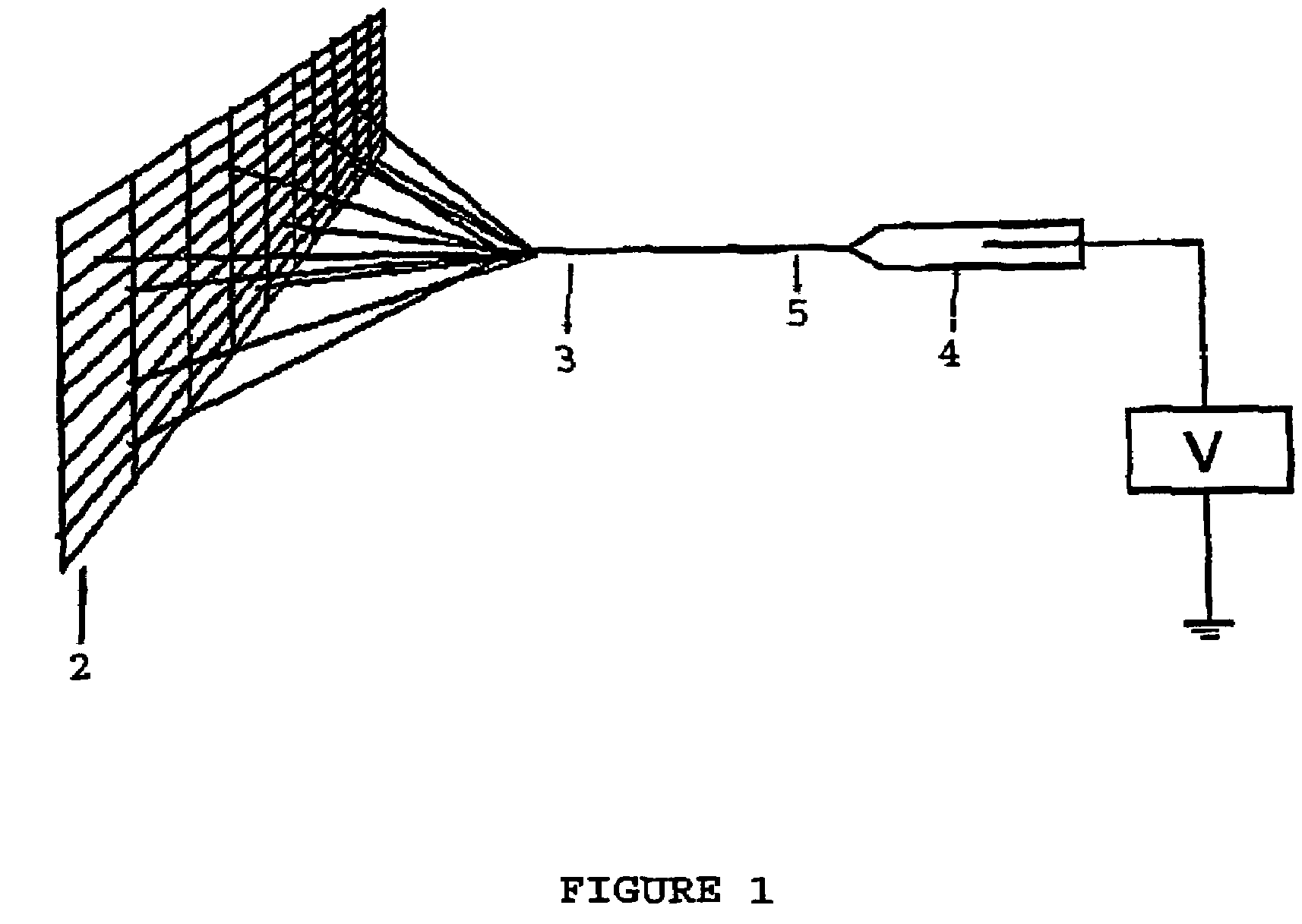Electrospinning ultrafine conductive polymeric fibers
a technology of conductive polymeric fibers and ultrafine conductive fibers, which is applied in the direction of open-end spinning machines, continuous wounding machines, filament/thread forming, etc., can solve the problems of halting further cmos development and further cmos developmen
- Summary
- Abstract
- Description
- Claims
- Application Information
AI Technical Summary
Benefits of technology
Problems solved by technology
Method used
Image
Examples
example 1
Solution Preparation
[0029]Polyethylene oxide (PEO) (Mw 900,000 Dalton) and 10-camphorsulfonic acid (HCSA) and chloroform were purchased from Aldrich Chemical Co. Emeraldine base (Mw 120,000 Dalton) was obtained from Neste Chemical Oy (Finland 02151, ESP00). These chemicals were used without further preparation.
[0030]Various polymer blend solutions were prepared with the concentration of polyaniline doped with HCSA (PAn.HCSA) ranging from 0.5 to 2 wt % and the concentration of PEO ranging from 2 to 4 wt %. By varying the ratio of polyaniline to polyethylene oxide, the concentration of doped polyaniline in the blend varied between 11 wt % and 50 wt %. These polymer blend solutions were prepared by first dissolving the exact amount of HCSA required to fully dope the emeraldine base in chloroform. The emeraldine base was slowly added to the chloroform solution with vigorous stirring at room temperature. This solution was allowed to stir for 2 hours and subsequently filtered using a No. ...
example 2
[0031]The electrospinning apparatus, as shown in FIG. 1, used a variable high voltage power supply purchased from Gamma High Voltage Research (Ormond Beach, Fla.). The glass pipette used in these experiments had a capillary tip diameter of 1.2 mm, and the pipette was tilted approximately 5° from horizontal so that a small drop was maintained at the capillary tip due to the surface tension of the solution. A positive potential was applied to the polymer blend solution, by inserting a copper wire into the glass pipette. The apparatus also consisted of a 10×10 cm copper plate placed 26 cm horizontally from the tip of the pipette as the grounded counter electrode. The potential difference between the pipette and the counter electrode used to electrospin the polymer solution was 25 kV.
example 3
Characterization of the Electrospun Fibers
[0032]The fiber diameter and polymer morphology of the electrospun PAn.HCSA / PEO fibers were determined using scanning electron microscopy (SEM). A small section of the non woven mat was placed on the SEM sample holder and was sputter coated with gold via a Denton Desk-1 Sputter Coater (Denton Vacuum, Inc. Moorestown, N.J. 08057). An Amray 3000 SEM (Amray, Inc. / KLA-Tencor Corp., Bedford, Mass.) using an accelerating voltage of 20 kV was employed to the take the SEM photographs.
[0033]The conductivity of the electrospun PAn.HCSA / PEO fibers and the cast film on a microscope glass was measured using the four-point probe method. The thickness of the non-woven fiber mat and the cast films were measured using a digital micrometer (Mitutoyo MTI Corp. Paramus, N.J.) with a resolution of 1 μm. The current was applied between the outer electrodes using a PAR 363 (Princeton Applied Research / Perkin Elmer Instruments, Inc., Oak Ridge, Tenn.) and the result...
PUM
| Property | Measurement | Unit |
|---|---|---|
| diameter | aaaaa | aaaaa |
| diameter | aaaaa | aaaaa |
| diameter | aaaaa | aaaaa |
Abstract
Description
Claims
Application Information
 Login to View More
Login to View More - R&D Engineer
- R&D Manager
- IP Professional
- Industry Leading Data Capabilities
- Powerful AI technology
- Patent DNA Extraction
Browse by: Latest US Patents, China's latest patents, Technical Efficacy Thesaurus, Application Domain, Technology Topic, Popular Technical Reports.
© 2024 PatSnap. All rights reserved.Legal|Privacy policy|Modern Slavery Act Transparency Statement|Sitemap|About US| Contact US: help@patsnap.com









